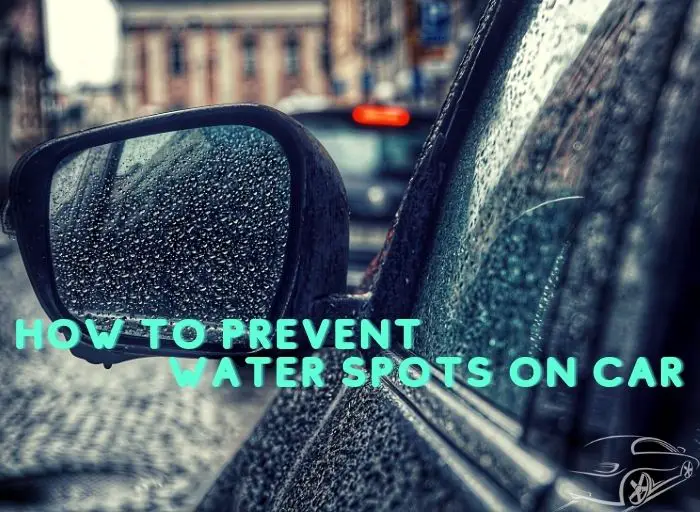
There are car owners that wish to keep their rides spotless with a shiny finish. Knowing how to prevent water spots on car is essential. In order to maintain an immaculate appearance, there are a few preventative measures that should be taken. Not only will these steps help from producing unsightly water spots, but they also act as a protective barrier for the paint job.
So, what exactly do you need to do to prevent water spots on cars? Let’s find out.
Table of Contents
What Are Water Spots?
Water spots are a type of weathering that occurs due to the action of water on the surface of the surface. It is a common problem for car owners after rain or snowfall.
Wondering: What should you do with water spots on black cars?!
The main cause is the accumulation of dirt, debris, bugs, and bird droppings on the tarmac undercarriage. These particles cause scratches to the paint’s finish.
Mineral deposits vs Etching
Mineral deposits and etching are two different types of imperfections that can affect a car’s paintwork. Let’s differentiate between them and discuss the impact of water spots on the car’s paintwork.
Mineral Deposits
Mineral deposits, also known as water spots or hard water spots, are residues left behind when water droplets evaporate. These spots typically contain minerals like calcium, magnesium, or other impurities present in the water. Mineral deposits can be stubborn and difficult to remove if left unattended for a long time.
- Appearance: Mineral deposits appear as white or light-colored spots on the car’s paint surface. They are often irregular in shape and can vary in size.
- Cause: When water droplets containing minerals evaporate on the car’s surface, the minerals are left behind and create these spots.
- Removal: Mild mineral deposits can often be removed with gentle washing and drying techniques. However, if they are left untreated for too long, they can etch into the paint and become more difficult to remove.
Etching
Etching refers to the damage caused to the clear coat or paint layer of a car’s finish. It occurs when certain substances come into contact with the paint and chemically react, causing the surface to corrode or dissolve. Etching can occur due to various factors, such as acidic substances or prolonged exposure to contaminants.
- Appearance: Etching appears as dull, discolored spots or marks on the car’s paintwork. These spots may have a different texture and can range in size and shape.
- Cause: Etching can be caused by acidic substances like bird droppings, bug splatters, tree sap, or harsh chemicals. These substances react with the paint surface, causing damage.
- Repair: Etching can be challenging to repair and often requires professional intervention. Depending on the severity, it may involve paint correction techniques, such as polishing or even repainting the affected area.
Impact of Water Spots on Car’s Paintwork

Water spots, if left untreated, can lead to several negative effects on a car’s paintwork:
- Etching: As mentioned earlier, water spots can potentially etch into the paint surface if not removed promptly. The minerals in the water spots can react with the paint, causing permanent damage and requiring more extensive repairs.
- Discoloration and stains: Water spots can leave behind unsightly marks and discoloration on the car’s paintwork. Over time, these stains may become more challenging to remove, detracting from the vehicle’s appearance.
- Reduced gloss and clarity: Accumulated water spots can create a hazy or dull appearance on the paint surface, diminishing the paint’s gloss and clarity. This can make the car look less vibrant and well-maintained.
- Potential for further damage: If water spots are not regularly addressed, they can act as a barrier, trapping dirt, dust, and other contaminants on the paint surface. This buildup can further degrade the paintwork, leading to more extensive damage over time.
Causes of Water Spots
To prevent the appearance of water spots, we need to understand why they occur. Here are the three main reasons:
#1 Hard water and its mineral content
Hard water is water containing a high concentration of dissolved minerals such as calcium, magnesium, and other impurities. These minerals are present in the water supply of certain regions and can contribute to the formation of water spots.
When hard water evaporates on the car’s surface, the minerals in the water are left behind as residues. As the water droplets evaporate, the minerals form visible spots on the paintwork.
#2 Environmental factors such as rain, dew, and sprinklers
Rainwater is generally considered soft water, meaning it has a lower mineral content. However, if rainwater mixes with pollutants in the atmosphere or collects on surfaces before falling onto the car, it can carry impurities that contribute to water spots.
Besides, dew is formed when moisture in the air condenses on surfaces during cooler temperatures, usually overnight. If the dew contains minerals or impurities, it can leave behind spots when it evaporates.
Water from sprinkler systems used for lawn irrigation or nearby garden watering can contain minerals or impurities. When these water droplets land on the car’s surface and evaporate, they can leave mineral deposits and create water spots.
#3 Improper car washing techniques
Here are some common mistakes people make when washing a car, leading to the present of water spots:
- Air-drying: Allowing the car to air-dry after washing can increase the likelihood of water spots. As the water evaporates, the minerals in the water are left behind, resulting in spots on the paintwork.
- Direct sunlight: Washing the car in direct sunlight or on a hot day can lead to water spots. The heat accelerates evaporation, leaving behind concentrated mineral deposits on the paint surface.
- Using hard water for washing: It can introduce minerals onto the paintwork if hard water is used during the car washing process. These minerals can then create water spots when the water dries.
- Improper drying techniques: Insufficient drying or using improper drying materials, such as dirty or abrasive towels, can spread minerals or contaminants on the car’s surface, leading to water spots.
Prevent Water Spots On Car: A How-to Guide!
You can check some water spot removers for cars on Amazon by clicking this link.

Water spots on cars are not avoidable, yet there are many preventative measures we can do to minimize them. The following practices will help remove water spots on cars and keep your ride looking for a long time.
Washing the car with a high-quality car shampoo
Using a high-quality car shampoo specifically formulated for automotive use helps in minimizing the chances of water spots. These shampoos are designed to be pH-balanced and reduce the presence of minerals or impurities that can cause water spots.
Using a clay bar to remove existing contaminants
Before applying any protective products, using a clay bar can help remove existing contaminants and residues from the car’s paintwork. This process helps create a smooth surface and reduces the likelihood of water spots adhering to the paint.
Applying a paint sealant or wax for added protection
Applying a paint sealant or wax creates a protective barrier on the car’s paintwork, making it easier to repel water and prevent the minerals from bonding to the surface. Regular application of a sealant or wax helps maintain the car’s shine and provides additional protection against water spots.
Using a water softener or water filter
If you have access to hard water, using a water softener or installing a water filter for your hose can help reduce the mineral content in the water used for washing your car. This minimizes the chances of mineral deposits and water spots forming during washing.
Drying the car thoroughly after washing

After washing your car, make sure to dry it thoroughly using a clean microfiber towel or drying cloth. Removing all traces of water prevents the minerals from drying on the surface and forming water spots.
Find out: What Are The Best Drying Towel for Black Cars?
Avoiding parking under trees or near sprinkler systems
Parking your car away from trees and sprinkler systems reduces the risk of water droplets or sap falling onto the paintwork and causing water spots. Also, it helps prevent contaminants from settling on the car’s surface, which can contribute to water spot formation.
Using pH-neutral car shampoos and soaps
Using pH-neutral car shampoos and soaps ensures that the cleaning agents are gentle on the paintwork and do not leave behind residues that can lead to water spots.
Waterless or rinseless car wash products
Waterless or rinseless car wash products are designed to clean the car’s exterior without requiring a full water rinse. These products contain lubricants that encapsulate dirt and contaminants, allowing them to be safely wiped away without leaving behind water spots.
Quick detailers and spray waxes for spot cleaning
Keeping a quick detailer or spray wax handy allows you to quickly and easily remove small water spots or contaminants that may have appeared between regular washes. These products provide lubrication and protection while cleaning the surface.
Using the two-bucket method
When washing your car, utilize the two-bucket method. Fill one bucket with soapy water and another with clean water for rinsing your wash mitt or sponge. This helps prevent dirt and contaminants from being transferred back onto the car’s surface, reducing the chances of water spots.
Using a microfiber wash mitt or sponge

Opt for a high-quality microfiber wash mitt or sponge when washing your car. These tools are gentle on the paintwork, minimize the risk of scratching, and help remove dirt and contaminants effectively.
Rinsing the car with a gentle stream of water
When rinsing the car, use a gentle stream of water instead of high pressure to prevent water droplets from splashing and causing mineral residue to dry on the surface. A gentle stream helps minimize the chances of water spots during the rinsing process.
What Ways & Products To Remove Water Spots
1. Varnish
Another effective way to prevent water spots on the car is by applying a clear coat of varnish to protect the car’s surface.
2. Quick-Dry
If you want to remove water spots on your car quickly and efficiently, try using a quick-dry product. It will work best to dry up the water and give time for excess water to be drained from its surface.
3. Rain Guard
There are also rain guards that can be used to prevent water spots on cars. However, this applies only to those vehicles that have a roof or windows.
4. Car Wax
There is also some car wax that has ingredients that will eliminate marks from your vehicle’s surface, including water spots on the car.
Related: Does Ceramic Coating Prevent Water Spots?
5. Baking Soda
Another effective way to get rid of water spots on a car is by using baking soda.
6.Tar Removers
Another kind of tar remover that can prevent water spots on cars is a tar remover.
7. Water Spot Remover
Another effective way to prevent water spots on cars is by using a water spot remover. This product used to have fancy names like “rainbow wax” but is quite similar to hand soap.
8. White Vinegar
Another effective way to prevent water spots on cars is by using white vinegar. You need to mix warm water and white vinegar in the ratio of 1:15.
Check out this video from Chemical Guys on how to prevent water spots after wash!
What Are Hard Water Spots? And How to Remove Them!
Hard water spots are just the same as water spots. The difference is in how they appear. They appear in a very hard form, and they are white and yellow.
Some areas have stains that look like white-yellow mineral deposits but also hard water spots. In most cases, this kind of water spot is a kind of sign that the hard water’s mineral content has already damaged your vehicle’s paint.
There are so many modern products that you can use to get rid of hard water spots – both the good and the bad ones. There is bleach, hair lotion, toothpaste, fabric softener, wax, tar removers, de-solvents, and more. There are also some home remedies that you can try with this kind of water spot.
You need to mix baking soda with some warm water together to form an effective paste. In this case, you will need to use the paste in order to remove the hard water spots on your vehicle’s finish.
4 Ways to Get Rid of Hard Water Stains
If you want to get rid of the hard water stains that are already present on your vehicle’s finish, then you can do this by mixing a few ingredients together.
Method 1: Using baking soda, toothpaste, and water
- Baking soda
- Toothpaste
- Water
You can either use these ingredients separately or mixed together in one bucket.
First, you apply the toothpaste to let it sit for a few minutes. After that, you will need to use a cloth or sponge and then apply the baking soda paste for about 10 minutes.
Then, you use warm water to rinse the paste off of your vehicle’s finish. The result is a clean and shiny finish.
Method 2: Using dishwashing soap and hot water
Another method that you can do is by mixing two teaspoons of dishwashing soap with a gallon of hot water. After that, you will apply this mixture to your vehicle’s finish and wait for it to dry completely. Then, you will use a soft cloth to wipe the spot off gently.
Method 3: Using olive or avocado oil
You can also apply olive or avocado oil on the spot and scrub it away with an old toothbrush. The oils will help remove hard water spots by loosening up the mineral deposits on your vehicle’s finish.
Method 4: Using polishing pads
You can also use a plastic polishing pad to remove hard water stains on your vehicle’s finish. You can do this by mixing equal parts of floor wax, rubbing alcohol and water together, and then applying it to the spot. You must rub the mixture with the polishing pad until it is completely gone.
In this case, you will need to apply hot water and some gentle soap in order to prepare the surface for further cleaning.
Check out this video for how to remove water spots with various products!
What Are Soft Water Spots as Well? And How to Get Rid of Them!
Soft water spots are formed in the same way as hard water spots. The main difference could be that soft water spots are not very hard. They may also appear more like water stains than actual hard water spots. Soft water stains can be formed by soap, shampoo, and other products exposed inside and out of your vehicle’s finish.
Read More: Water Spots on Black Car: What Can You Do With Them?
As mentioned above, there are plenty of modern products that you can use to get rid of water spots. The good thing about those modern products is that they are specifically made for this job.
Here are some examples:
1. Meguiars Gold Class Wheel Cleaner
There is a brand of wheel cleaner that you can use to remove soft water spots from your vehicle’s finish. This cleaner will easily dissolve all types of brake dust and other contaminants at once. It is safe to use and will not damage the delicate finish of your vehicle’s paint. This cleaner is highly concentrated and will last a long time. It is also very easy to use because it comes with a foam applicator.
2. Meguiars D15601 Mirror Glaze #1 Cleaner Wax
You can use another product to remove soft water spots from your vehicle’s paint finish. This cleaner wax is made especially for automobiles and all vehicles painted with a clear coat finish. In most cases, this product can last for several months and is resistant to any UV rays that can fade the shine of your vehicle’s paint.
This cleaner is also very easy to use because it is packaged in a convenient bottle. It will not leave any scratches, and it will not streak.
3. Meguiars D12002 Hot Rims Wheel Cleaner
You can also use another product to remove soft water spots from your vehicle’s finish. This cleaner is the same as the one above but is also available for wheel cleaning. This cleaner will not only clean your wheels but also protect them from future water spots and dirt that can cause discoloration.
The best part about this product is that it can be used for both car and truck rims.
4. Zymol Correct Polish
There is yet another great product that you can use to remove soft water spots from your vehicle’s paint finish. This polish is made from natural ingredients that are safe for your vehicle’s finish. It will help remove hard or soft water spots from your vehicle’s paint finish. This polish is also very easy to use because it comes with a sponge applicator. It will help you apply it on the spot without any difficulties at all.
5. Bio-Glide Car Wash
You can also use one more product to remove soft water spots from your vehicle’s finish. This product is made by professionals with more than thirty years of experience. This product is designed for cars and trucks with a clear coat of paint finish. It will help you remove any hard water or soft water spots on your vehicle’s paint finish without causing any harm to it. It can also be used as a soap and lotion to keep your vehicle’s finish fresh.
FAQs
#1 Does WD-40 Remove Calcium Deposits?
Yes, it does. In fact, WD-40 can also dissolve calcium deposits and hard water stains on your vehicle’s finish.
#2 How Long Do Soft Water Spots Last?
They can last for several years depending on the type of your vehicle’s finish. What is the best product that you can use to remove hard water spots from your vehicle’s finish?
You can choose several products, but we recommend that you choose Meguiars Gold Class Wheel Cleaner.
Find Out: Do Tonneau Covers Keep Water Out?
#3 How Do You Get Rid of Stubborn Calcium Deposits?
If you are still facing the problem of removing stubborn calcium deposits from your vehicle’s finish, you can do it using warm water and baking soda.
You must use a sponge to apply the paste to the stain. Then, you will leave it there for about 10 minutes before washing it off with warm water. For the best result, be sure that the baking soda is completely dissolved in the water before lathering the sponge in order to get rid of all calcium deposits from your vehicle’s finish.
#4 Are Water Spots Bad for Car Paint? Can Water Spots Damage Car Paint?
Yes, water spots are bad for car paint. They will definitely cause harm to your vehicle’s finish if they are not removed. This is why you should remove them as soon as you notice them on your finish.
#5 Are Water Spots Harmful to a Car?
Yes, water spots can be harmful to your car. They can damage the paint of your vehicle, which means that your vehicle needs a professional touch to restore its finish’s shine and luster.
#6 Will Car Polish Remove Water Spots?
Yes, car polish can remove water spots. However, you have to do it correctly. Make sure that you use the right kind of car polish in order to get rid of water spots from your vehicle’s finish. It will also depend on how severe or mild the spots are. There are car polishes that are made just for that purpose.
#7 Does Wax Prevent Water Spots?
It depends on the type of car wax that you are using. For example, there are water spot removers that come with waxes in order to prevent water spots. In most cases, these products will take away many calcium deposits that can cause hard water spots on your vehicle’s finish.
#8 Can Water Spots Be Prevented Completely?
Water spots cannot be completely prevented, but their occurrence can be significantly reduced by taking preventive measures such as using proper car washing techniques, employing protective products like sealants or waxes, and drying the car thoroughly after washing. These measures help minimize the chances of water spots forming on the car’s paintwork.
Wrapping Up
As you can see, we have discussed several products you can use to remove hard water or soft water spots from your vehicle’s finish. However, we recommend that you choose the abovementioned products because they are all tested and proven effective in safely removing such stains.
Do not wait for hard water or soft water spots to damage your car finish. Remove them as soon as possible so that you will not need to spend extra money on getting it repaired later on. Always keep in mind that prevention is better than cure.
Further Reading:
Hi everyone, My name is Ollie Barker.
As a seasoned auto expert I have 25 years of experience working in repair and detailing shops. I love to share my tips & tricks to all car lovers, so that’s why I’m here at Automotive Gearz publishing my content, sharing my passion. Also, I’ve been giving my recommendations on which products are the best to have on the market. I always thought it was hard to pick the right part, so hopefully I can make that a bit easier for you.
Hope you enjoy your time on my little blog!







